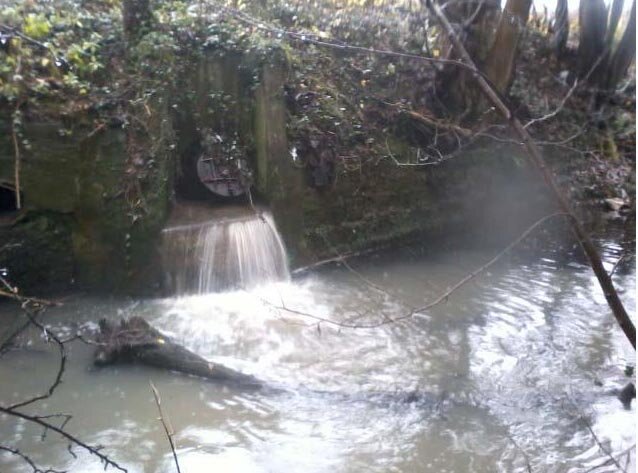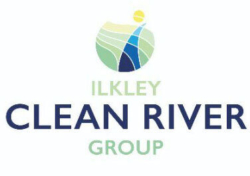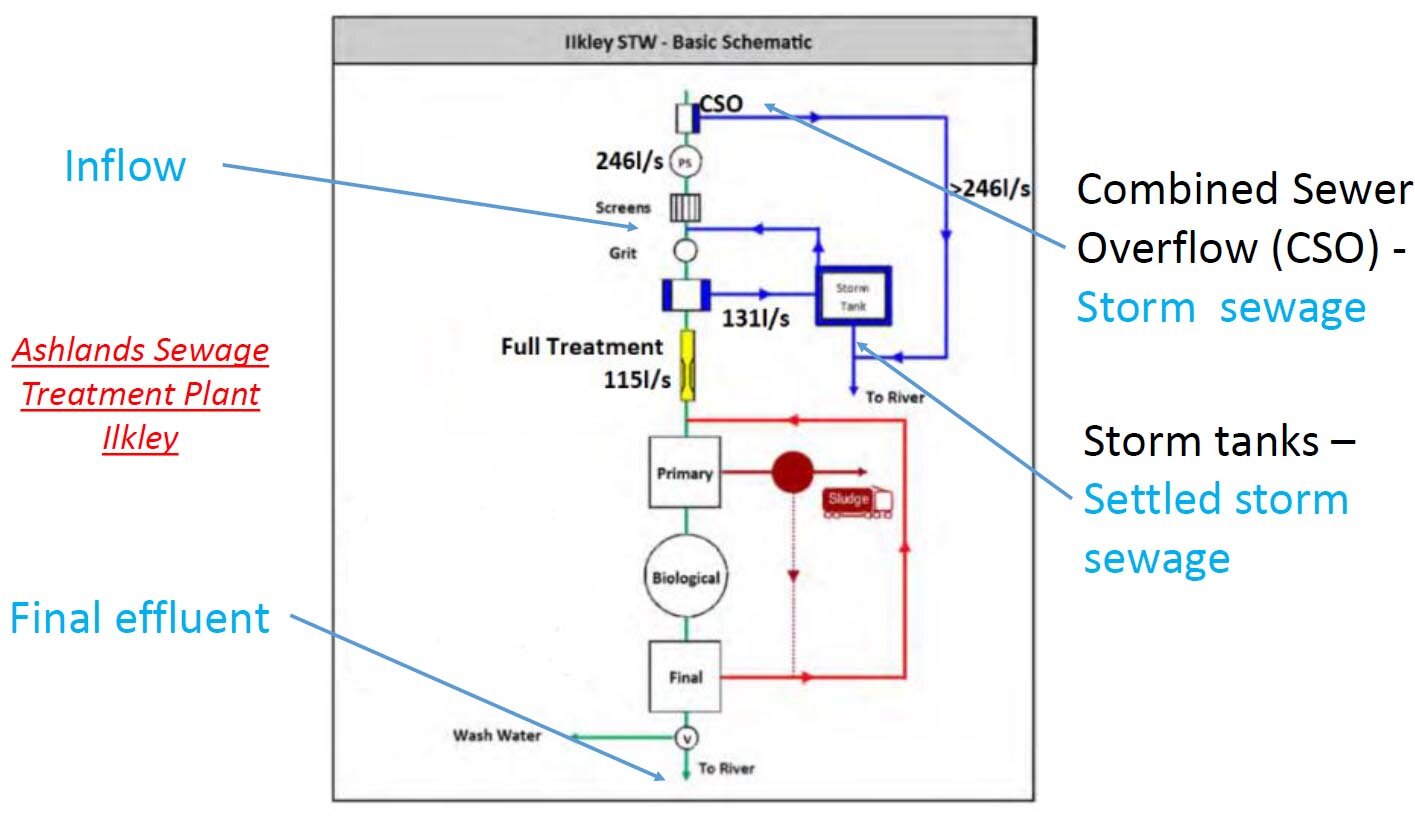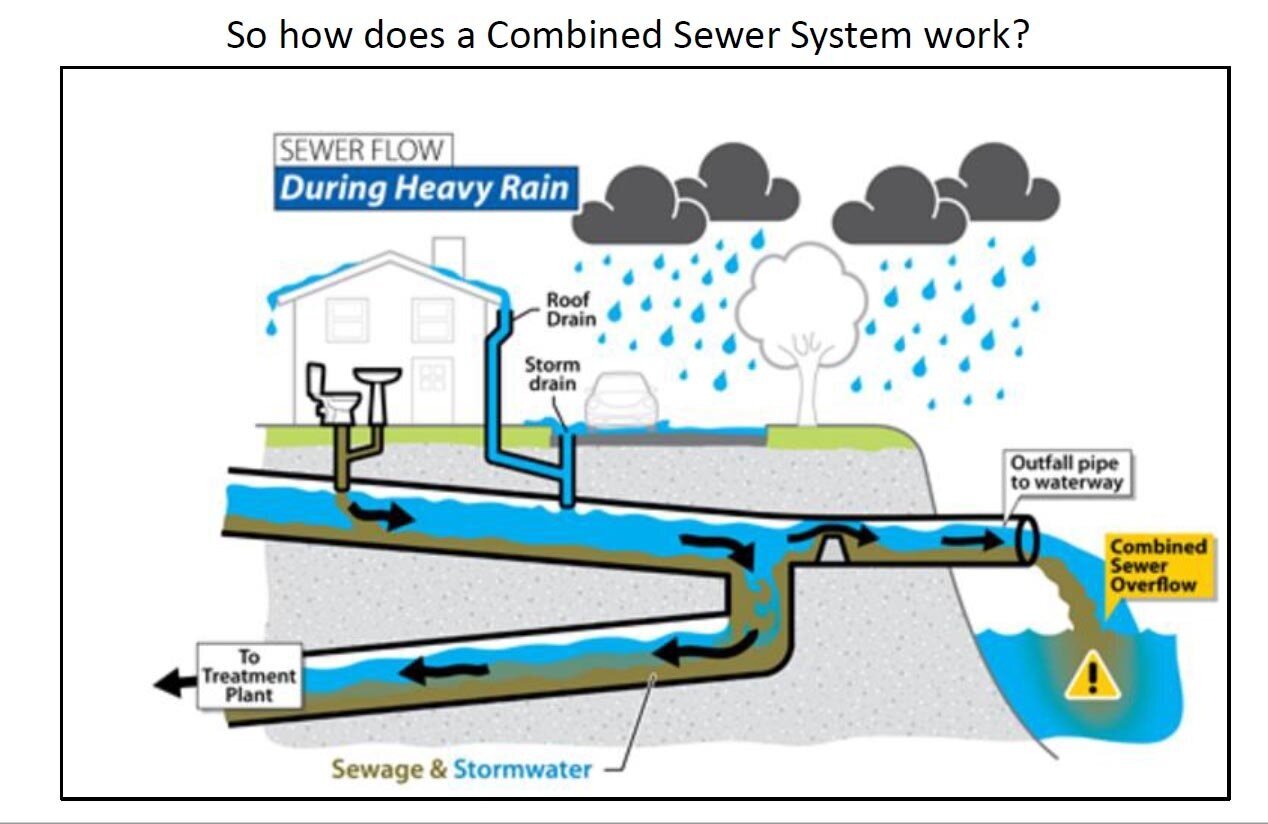HOW CLEAN IS THE WHARFE?
• By and large the general public is unaware that rivers are used to discharge not only treated effluent but also untreated effluent directly to rivers;
• It’s (almost) all quite legal , permitted under licence by the Environment Agency;
• The EA advise against swimming in rivers;
• Both the water industry and the EA have been content with these arrangements; and,
• Spills during heavy rainfall events usually go unnoticed, because outlet pipes are often hidden from view.

UK Government Environment Bill (Oct 2021)
According to legislation of 1991, all sewage should be treated unless extreme weather incidents prevent it i.e. flood events that may cause back up into peoples homes. This is clearly being breached evidenced by records from water companies themselves.
In October 2021, the government had the opportunity with the Environment Bill to put it beyond all doubt that water companies have to act to stop pumping raw sewage into rivers and the ocean. Instead they decided to recommend their MPs reject key amendments that would have stopped water companies exploiting legal loopholes and treating rivers and the ocean as open sewers.
400,000 sewage pollution events (UK wide) in a year doesn’t sound like very effective legislation to us. Putting this legal duty on water companies to take steps to reduce their reliance on overflows (into water courses) would have made a real difference by forcing them to finally tackle their shocking sewage pollution record.
The parliamentary vote was very close but MPs from all parties voted in support of the amendments which changed the emphasis of “ceasing” the outflows, to a very spurious and, unmeasured “impact” of pollution.The public outrage sent a clear message to Ministers that much more must be done.
Ilkley Clean River Group reacted with an open letter to all MPs outlining our views, and, evidently those of many others. Read the letter here:-
Write to your MP NOW!
Ashlands Sewage Treatment Works (STW)
There are two different but related issues: the problem of untreated storm discharges and nutrient phosphorus pollution by treated (final) effluent.
Standard waste-water treatment plants such as the one in Ilkley are designed to remove organic matter from the waste-water arriving at the plant before discharging the treated effluent to a water course.
Ashlands STW waste-water includes surface water from rainfall. Such “Combined Sewer systems” are a problem as the flow of waste-water into the plant, especially after heavy rainfall events, can quickly exceed its capacity. As a result, combined sewer overflows (CSOs) are placed on the network to relieve pressure in the system and prevent internal and external flooding.
When treatment capacity is exceeded, waste-water is pumped into storm-water tanks where the untreated water is held and released back for treatment once excessive inflow has subsided. Ashlands has four tanks designed for this purpose with a total capacity of 826 cu m.
If the storm tanks fill to capacity before the flow has subsided the waste-water overflows untreated directly into the river.
In very high flow conditions when the capacity for the incoming waste-water is exceeded, in Ashlands the inflow capacity is 246 litres/sec, waste water is released, untreated but under permit, directly into the Wharfe.
Following prolonged rainfall raw sewage can be discharged simultaneously both directly into the river (when the inflow rate is exceeded) and indirectly (once the storm tanks are full).
Some mitigation has been introduced at Ashlands since the summer of 2018. Screens and pumps, not required by the permit, have been upgraded. The new pump lifts additional flows into the storm tanks and the new screen will replace the current screen on the overflow to retain more debris.
Consent Limits
The Consent Limits for the discharge of untreated sewage from Ashlands Sewage Treatment Works into the River Wharfe were set in 2002. Under the EU Urban Wastewater Treatment Directive, now, post-Brexit, written into UK law, such discharges should only occur after heavy rainfall. However, in recent years untreated effluent is discharged frequently and often after only light rainfall.
In 2018 Yorkshire Water reported 123 days of sewage discharges, in 2019 there were 201 discharges over 114 days and in 2020 provisional data show that there were discharges on more than 120 days, only 10 of which occurred in heavy rainfall conditions.
It appears that Ashlands is well in breach of its consent limits. These need to be reviewed by the Environment Agency, especially as the EA’s own rules using the Storm Overflow Assessment Framework (SOAF) require an investigation to be carried out when there are more than 40 ‘spills’ a year over 3 years or more than 60 spills in a single year.
However, to review the limits the Environment Agency has to be able to show that the discharges are causing a decline in the ecological status of the river under the Water Framework Directive (WFD). The formal WFD classification for the stretch of the Wharfe in Ilkley is “moderate” but this is based not on water quality but on the physical condition of the river channel and its impact on the movement of fish. If only the criteria for nutrient chemistry and macro-invertebrate populations are used in the WFD assessment then the status is “good”. The EA acknowledge that the discharges from Ashlands have an impact on the ecology of the river downstream but maintain that the impact of the discharges is not sufficiently high for its WFD status to be downgraded from good to moderate. Consequently the EA maintain they have no grounds to take action against Yorkshire Water.
Faecal bacteria and human health
Discharges of effluent whether treated or not cause ecological damage mainly by increasing nutrient concentration in the water. This is monitored by the EA under WFD. However, effluent discharge also adds very high concentrations of faecal bacteria to the river. Faecal bacteria are not a serious problem for wildlife but they are a problem for humans using the water.
The EA monitors these organisms at bathing beaches under the EU Bathing Waters Directive. In the UK such beaches only occur on the coast and at a small number of lakes, although now, as a result of the success of the ICRG campaign, monitoring for faecal bacteria has begun for the first time on a river site.
Over the next five years the EA will monitor the concentrations of Escherichia coli (E. coli) and Intestinal enterococci (IE) at the Crumwheel corner on the Wharfe routinely and Yorkshire Water will be required to identify the sources of faecal bacteria in the river and introduce measures designed to meet the standards for safe swimming.

Population Increase and Property Development?
A large number of new homes are being built or are planned for Ilkley and Addingham. Although new development should not add to surface water flows as developers are no longer allowed to route rainfall into the foul sewers, dry weather flows will be increased in proportion to the number of households connected to the sewer network. For Ilkley and Addingham combined, a population increase of approximately 3000 is expected over the next decade leading to a dry-weather flow increase of up to 15%, leaving less headroom for surface water.
Will the problem become more serious?
It is not yet clear how Yorkshire Water will be able to reduce the number of spills that occur. Without decombining the combined sewer network, flows of sewage into the plant cannot be easily reduced and the capacity of the plant, e.g. by increasing the capacity of stormwater tanks, cannot be easily changed. Work is proposed to decrease the amount of groundwater infiltration that enters the sewer network but Yorkshire Water’s modelling indicates that controlling groundwater ingress will only lead to a 20% reduction in the number of spills that occur. As the frequency and severity of heavy rainfall events is likely to continue increasing as a result of climate change the frequency of untreated effluent discharges is unlikely to decrease to any significant extent.
We’re planning a follow up this summer called “iwharfe21”. It will be a repeat of last year’s survey but hopefully catching the river at low flow to identify more clearly point sources of pollution. we’ll have our teams ready to go at short notice if and when we hit a period of prolonged dry weather.


